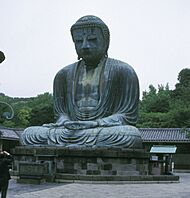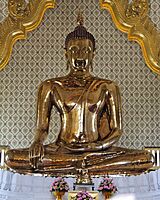Buddha in art facts for kids
|
Basic terms |
|
|
People |
|
|
Schools |
|
|
Practices |
|
|
study Dharma |
|
Buddharupa are statues or pictures of the Buddha. The word "Buddharupa" comes from Sanskrit and Pali, meaning "Form of the Awakened One." Most often, these images show Gautama Buddha, who was the first Buddha. But sometimes, they show other important figures in Buddhism, like those who have reached Buddhahood or bodhisattvas.
For a long time, early Buddhist art did not show the Buddha as a person. Instead, they used symbols or relics (special objects). Later, around the first centuries CE, artists started making figures of the Buddha. These became very popular in places like Gandhara and Gupta India. In Theravada Buddhism, statues of Gautama Buddha are still the most common images in temples today.
Early statues often showed the Buddha standing. But soon, seated positions, like the lotus position used in yoga, became more common. These poses often show a special moment from the Buddha's life. You can tell what moment it is by looking at his hand gestures, called mudras. There are also statues of the Reclining Buddha, which show him lying down, usually at the time of his death.
Artists also create scenes from the Buddha's life. These often show important events, like the Eight Great Events. They might be carvings or paintings. Even in these scenes, the Buddha is usually shown in his common standing, seated, or lying poses. Other figures or his mudra help tell the story.
Contents
What Do Buddha Statues Look Like?
Even though Buddha statues come from different cultures, they often share similar features. These features are based on descriptions of Gautama Buddha:
- Long fingers and toes
- A long, curved nose
- Long earlobes
- A bump on the top of the head
- Broad shoulders
The long earlobes remind us that the Buddha was once a prince. He wore heavy, fancy jewelry that stretched his ears. The bump on his head is called the ushnisha. It stands for his deep wisdom, spirituality, and enlightenment.
Buddha Statues Around the World
The way Buddha is shown can look very different depending on the country.
Different Styles and Shapes
Buddha images first appeared in North India around the first century CE. They developed in regions like Gandhara and Mathura. Art from Gandhara was influenced by Ancient Greek art. This led to Greco-Buddhist art, which showed the Buddha with realistic body shapes. Later, Gupta art and the Amaravati style became very important.
From India, the way Buddha was shown spread across Asia. Statues from India, Sri Lanka, Java (like at Borobudur), and Cambodia usually show a well-proportioned figure. Sometimes, though, he is shown very thin. This reminds us of the years the Buddha spent practicing asceticism (living without comforts).
Many people know the "Happy" or "Laughing" Buddha. This is actually a different historical person. He should not be confused with images of Gautama Buddha. This monk, named Budai (or Hotei), was Chinese. He is shown as fat and happy, often smiling or laughing. He is linked to Maitreya, who is believed to be the future Buddha.
Hand Gestures and Meanings
Every Buddha statue or painting shows a mudra, or hand gesture. There are many different mudras, but some are very old and common. In Mahayana Buddhism, some of these gestures are also linked to five special Buddhas, called "Dhyani Buddhas." This can make it tricky to know exactly which Buddha is being shown.
Here are some common mudras:
- Dharmachakra Mudra – Teaching Gesture: Both hands are held in front of the chest. The tips of the thumbs and pointer fingers of each hand touch. This mudra shows the Buddha teaching.
- Bhumisparsa Mudra – Earth-Touching Gesture: The right hand touches the ground near the right knee. The Buddha made this gesture to call the Earth to witness his enlightenment. This mudra is also connected to the Maravijaya attitude.
- Varada Mudra – Granting Wishes Gesture: The right hand is open, palm facing out, with fingers pointing down. The left hand often holds an alms bowl. In Sanskrit, "Varada" means "giving a gift." This gesture shows giving blessings or wishes.
- Dhyana Mudra – Meditation Gesture: The left hand rests in the lap, palm up. The right hand rests on top of the left, also palm up. The two thumbs touch. Sometimes, a bowl is placed in the palms. This gesture shows deep meditation and the balance of wisdom and kindness.
- Abhaya Mudra – Fearlessness Gesture: The left hand is raised, palm facing out, with all fingers pointing up. This gesture means protection and fearlessness. It is said that following the path of a Bodhisattva helps one become fearless.
Images of the Buddha lying down show his Parinirvana. This means his final departure into nirvana at the time of his death.
Sometimes, the Buddha holds special objects or makes other symbolic gestures.
The clothes on Buddha statues also change based on the country. In East Asia, they often look like local monk robes, covering the arms. In India, especially in warmer areas like Mathura, early statues might show the Buddha with very thin robes or even topless.
|






